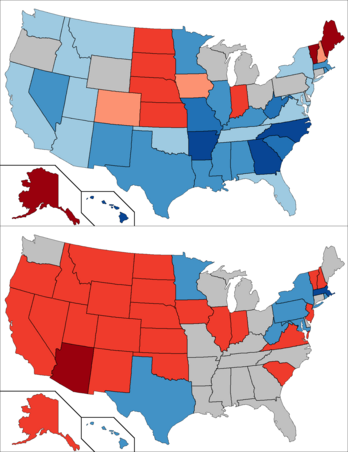 | ||
| ||
|
| ||
 United States presidential election results between 1932 and 1960 (Fifth Party System) and 1964 to 1976 (Dealignment). Blue shaded states usually voted for the Democratic Party, while red shaded states usually voted for the Republican Party. | ||
The Fifth Party System, also known as the New Deal Party System, is the era of American national politics that began with the election of Franklin D. Roosevelt to President of the United States in 1932. Roosevelt's implementation of his popular New Deal expanded the size and power of the federal government to an extent unprecedented in American history, and marked the beginning of political dominance by the Democratic Party that would remain largely unbroken until 1952. This period also began the ideological swapping of Democrats and Republicans into their modern versions. This was largely due to traditionally Republican Black voters switching to the Democratic Party, while conservative, White, and southern Democrats shifted to the Republican Party. This occurred as Democrats began increasingly prioritizing civil rights, a process that accelerated into the 1960s.[1] The Fifth Party System followed the Fourth Party System, also known as the Progressive Era, and was succeeded by the Sixth Party System.
The New Deal coalition that cemented the Fifth Party System and allowed Democrats to dominate the White House for 40-some years arose from the realignment of two similar third party factions into the Democratic Party: the Progressives in the Western Coast and the greater Rust Belt region (which includes New York, Massachusetts, Baltimore and New Jersey), and the Socialists in the Western Coast and Sun Belt. Realigning these two factions after the 1932 and 1936 elections allowed the Democratic Party to make inroads in the North for the first time since the Second Party System and made other non-South regions competitive.
- ^ Kersh, Rogan; Morone, James (2019). "By the People: Debating American Government". Oxford Handbooks Online: 406 (of 823).
